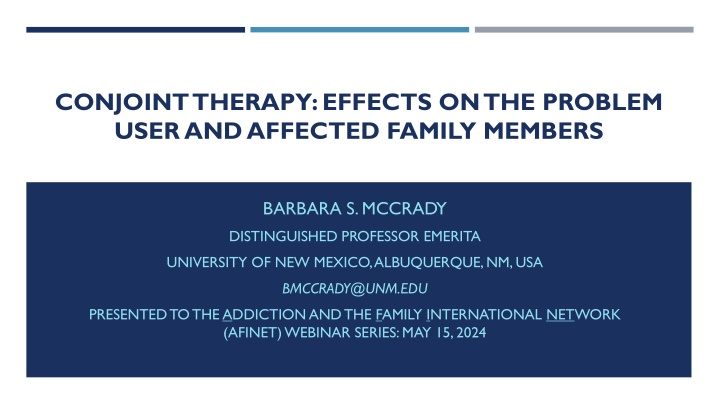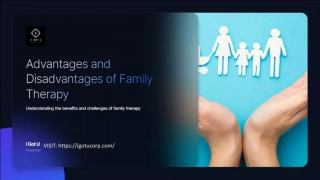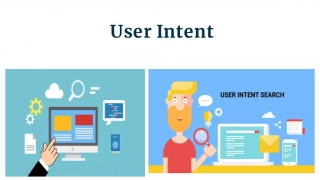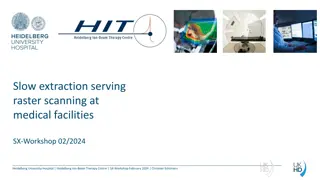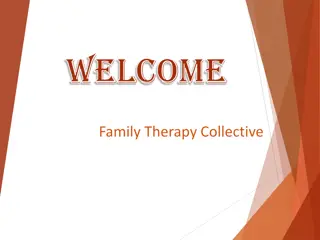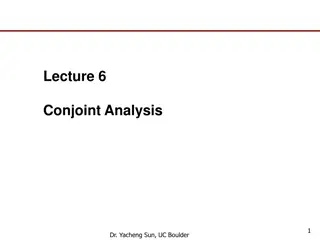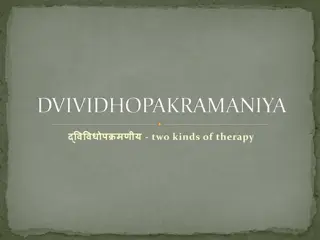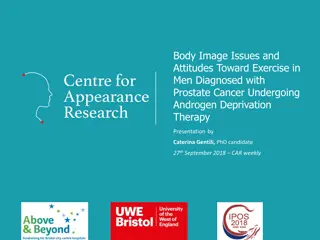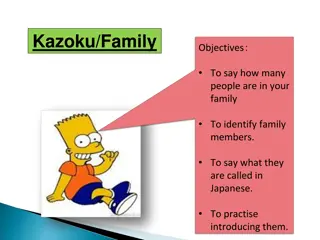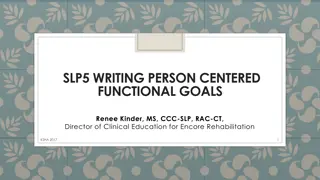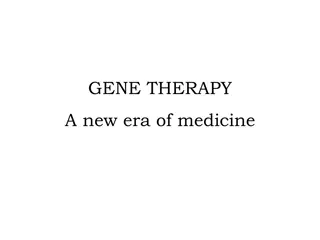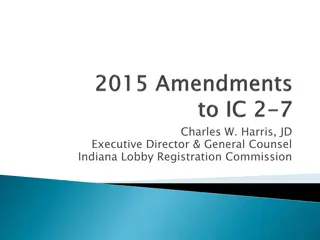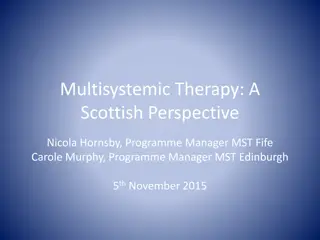Conjoint Therapy Effects on the Problem User and Family Members
Barbara S. McCrady presents research on the effects of conjoint therapy on individuals with alcohol problems and their families. The presentation covers family perspectives, treatment outcomes, and historical context. Insights from family focus groups and coding of family responses shed light on the impact of alcohol problems on families and barriers to treatment involvement.
Download Presentation

Please find below an Image/Link to download the presentation.
The content on the website is provided AS IS for your information and personal use only. It may not be sold, licensed, or shared on other websites without obtaining consent from the author.If you encounter any issues during the download, it is possible that the publisher has removed the file from their server.
You are allowed to download the files provided on this website for personal or commercial use, subject to the condition that they are used lawfully. All files are the property of their respective owners.
The content on the website is provided AS IS for your information and personal use only. It may not be sold, licensed, or shared on other websites without obtaining consent from the author.
E N D
Presentation Transcript
CONJOINT THERAPY: EFFECTS ON THE PROBLEM USER AND AFFECTED FAMILY MEMBERS BARBARA S. MCCRADY DISTINGUISHED PROFESSOR EMERITA UNIVERSITY OF NEW MEXICO, ALBUQUERQUE, NM, USA BMCCRADY@UNM.EDU PRESENTED TO THE ADDICTION AND THE FAMILY INTERNATIONAL NETWORK (AFINET) WEBINAR SERIES: MAY 15, 2024
OVERVIEW OF PRESENTATION Family perspectives Overview of our family-involved treatment model and outcomes Partner verbal behavior in sessions How identified patient and partner verbal behaviors relate to drinking outcomes. Summary and conclusions
A BRIEF HISTORICAL NOTE Professionals have long recognized the desperation of families affected by alcohol or drug problems and engaged them in the identified patient s (IP s) treatment Ex: Kerr (1889) described a man whose wife was an inebriate. The man, desperate to get his wife to change, decided to cover her with black paint when she was passed out after drinking. When she awakened, Kerr reported that she thought that a terrible disease had overcome her. The husband repeated these interventions over a month s time, after which she became sober. These same kinds of concerns have continued to the present day, although coping methods have changed Kerr, N. (1889). Inebriety or narcomania. Its etiology, pathology, and treatment and jurisprudence. NY: J. Selwin Tait & Sons.
FAMILY PERSPECTIVES: IMPACT OF ALCOHOL PROBLEMS ON THE FAMILY; FAMILY PARTICIPATION IN TREATMENT
FAMILY FOCUS GROUPS Conducted focus groups with families of individuals with alcohol or other substance use disorders How the problems had affected them Their thoughts about getting involved in treatment Perceived barriers to involvement McCrady, B. S., Wilson, A., Fink, B., Borders, A., Mu oz, R., & Fokas, K. (2019). A consumer s eye view of family-involved alcohol treatment. Alcoholism Treatment Quarterly, 37, 43-59.
CODING FAMILY RESPONSES Coding: Grounded theory approach to analyzing qualitative data Open coding by three researchers to identify preliminary codes similar themes and categories Four research team members coded one recording to refine themes and categories Axial coding to finalize coding themes and categories Double-coded all recordings Full team resolved coder disagreements
FAMILY FOCUS GROUPS: IMPACT OF AUD/SUD ON FAMILY Negative interpersonal She has this tendency to be verbally abusive, even with pushing me around and stuff like that Disrupted family relationships Anger and aggression towards the family Loss of trust Resource drain In the last two years, my ex-husband and I have spent at least $10,000 . . .programs, rehabs through the city, bonding her out when she s been drinking Inconvenience I have to come all the way over here and bring her, and that s the problem I m having, dealing with somebody that, how do we handle this, as a parent?
FAMILY FOCUS GROUPS: IMPACT OF AUD/SUD ON FAMILY - 2 Emotional impact Isolation, worry Impact on children Attempts to control drinking Reinforcing behaviors alternative to drinking Legal problems Involuntary commitment to treatment Setting boundaries/self-care
FAMILY FOCUS GROUPS: PERCEIVED BARRIERS TO FAMILY-INVOLVED TREATMENT Pragmatic challenges (time, distance, transportation) Relational barriers Family ambivalence Patient ambivalence Impact on self-concept Avoiding discussing drinking
FAMILY FOCUS GROUPS: PERSPECTIVES ON FAMILY- INVOLVEMENT IN TREATMENT Positive interpersonal impact When she came home, you d kind of at least want to talk about it, let them know that you re there for them, and if they want to open up and talk about it that s fine Optimism about family attendance Family members wanted to be involved, but weren t sure the IP wanted them involved From IP focus groups: wanted their families involved in treatment, but weren t sure family members wanted to be involved
CONCEPTUAL FRAMEWORK: GENERAL SYSTEMS THEORY Individual behavior and change can be understood at multiple levels: Intra-individual Proximal interpersonal relationships (family, friends) Larger social systems (work, school, community) Individuals in a social network have reciprocal influences on each other
CONCEPTUAL FRAMEWORK: FUNCTIONAL ANALYTIC Individual behavior can be understood in terms of: Intra-individual and environmental antecedents Intra-individual cognitive, affective, and physiological responses Behavioral responses Intra-individual and interpersonal consequences that maintain the behavior Change in behavior is motivated by: Recognizing and wanting to decrease the delayed negative consequences of the target behavior Wanting to increase positive rewards in their lives Incentives from the proximal and larger social networks McCrady, B. S., Epstein, E. E., & Holzhauer, C. (2023). Couple therapy in the treatment of alcohol problems. In: D. K. Snyder & J. Lebow (Eds.), Clinical handbook of couple therapy, 6thedition (pp. 554-575). Guilford Press.
WHAT IS ALCOHOL BEHAVIORAL COUPLE THERAPY (ABCT)? Focuses on the primary intimate relationship Draws on cognitive-behavioral approaches to: Alcohol use disorders Distressed relationships Includes 3 major treatment elements to: Teach abstinence skills Teach partner behaviors to cope with drinking and support change Improve intimate relationship David Abrams Nora Noel Beth Epstein
STRUCTURE OF TREATMENT Outpatient treatment Stand-alone treatment Both partners present for all sessions Sessions are 1 hours in length Treatment is manual-guided
WHAT HAVE WE LEARNED FROM OUR CLINICAL TRIALS? Addressing relationship issues along with drinking leads to better drinking and relationship outcomes than focusing solely on alcohol1 Adding relapse prevention elements to ABCT helps decrease the length of relapse episodes2 Combining ABCT with AA and Alanon does not enhance outcomes2 Couple therapy is more effective than individual treatment3 Couple therapy is more effective than individual treatment for women with other Axis I or Axis II disorders3 Women with AUD have greater hesitancy about conjoint therapy than men with AUD4 For women, providing a blend of individual and conjoint sessions enhances treatment engagement5 1McCrady, B. S., Noel, N. E., Stout, R. L., Abrams, D. B. & Nelson, H. F. (1991). Effectiveness of three types of spouse-involved behavioral alcoholism treatment: Outcome 18 months after treatment. British Journal of Addictions, 86, 1415-1424. 2McCrady, B. S., Epstein, E. E., & Kahler, C. W. (2004). AA and relapse prevention as maintenance strategies after conjoint behavioral alcohol treatment for men: 18 month outcomes. Journal of Consulting and Clinical Psychology, 72, 870-878. 3McCrady, B. S., Epstein, E. E., Cook, S., Jensen, N. K., & Hildebrandt, T. (2009). A randomized trial of individual and couple behavioral alcohol treatment for women. Journal of Consulting and Clinical Psychology, 77, 243-256. 4McCrady, B. S., Epstein, E. E., Cook, S., Jensen, N. K., & Ladd, B. O. (2011). What do women want? Alcohol treatment choices, treatment entry and retention. Psychology of Addictive Behaviors, 25, 521-529. 5McCrady, B. S., Epstein, E. E., Hallgren, K. A., Cook, S., & Jensen, N. K. (2016). Women with alcohol dependence: A randomized trial of couple versus individual plus couple therapy. Psychology of Addictive Behaviors, 30, 287-299.
ILLUSTRATIVE OUTCOMES: RUTGERS WOMENS TREATMENT PROJECT I RCT of 102 women with alcohol use disorders and their male partners Alcohol Behavioral Couple Therapy (ABCT) Alcohol Behavioral Individual Treatment (ABIT) Assessed at baseline, post-treatment, and 6- and 12-months post-treatment McCrady, B. S., Epstein, E. E., Cook, S., Jensen, N. K., & Hildebrandt, T. (2009). A randomized trial of individual and couple behavioral alcohol treatment for women. Journal of Consulting and Clinical Psychology, 77, 243-256.
ABCT AND ABSTINENCE 100 90 80 Percent Days Abstinent 70 60 ABIT ABCT 50 Treatment Follow-up 40 30 20 10 0 * * * * * * * * * * * * 4 5 6 7 8 9 10 11 12 13 14 15 16 17 18 1 2 3 Months
PSYCHOPATHOLOGY AND DRINKING FOLLOW-UP Women who came to treatment with significant psychological problems had more abstinent days by the end of follow-up after couples rather than individual therapy Women who came to treatment with personality disorders had fewer heavy drinking days by the end of follow-up after couples rather than individual therapy
LIMITATIONS/CHALLENGES OF ABCT Outcomes of ABCT are very positive However, it has not been adopted widely in clinical practice Why? Does not integrate easily with conventional treatment Takes many sessions Difficult to learn Too restrictive (intimate partners only) Potential solution: brief family involved treatment
MATES(MECHANISMS OF ALCOHOL TREATMENT ENGAGING SPOUSES) Goals: To study what actually happens in ABCT sessions To examine the impact of the therapist on the behavior of the couple To examine how the couple s behavior relates to drinking outcomes McCrady, B. S., Tonigan, J. S., Ladd, B. O., Hallgren, K. A., Pearson, M. R., Owens, M. D., & Epstein, E. E. (2019). Alcohol Behavioral Couple Therapy: In-session behavior, active ingredients and mechanisms of behavior change.Journal of Substance Abuse Treatment,99, 139-148.
MATES OVERVIEW Used therapy session tapes from four studies of ABCT (186 sessions) Session 1 Mid-treatment session Transcribed the sessions Coded the tapes for: Therapist behavior Identified patient (IP) specific utterances and global behavior Significant other (SO) specific utterances and global behavior
THE CODING SYSTEM SPECIFIC BEHAVIORS Negative behavior Neutral behavior Positive behavior Counter change talk Contempt Direct Confrontation Giving information Discussing self Change talk Support Collaboration Giving advice Providing encouragement/sup port
RESULTS: WHAT DO THEY TALK ABOUT? 40 35 Percent of utterances 30 25 IP SO 20 15 10 5 0 GIG GID ESG ESD AD DSG DSD Positive DI Negative CO CT CCT FN Mid-Treatment Session
THE CODING SYSTEM GLOBAL CODES Global codes of behavior across the session (1-5 scales) SO Support - Alcohol specific SO s overall influence, encouragement, and assistance to the IP when specifically related to the IP s drinking and abstinence SO Support General SO s overall emotional support, influence, encouragement, and assistance to the IP when specifically related to the IP s non-alcohol-related goals and concerns IP Support General IP s overall emotional support, influence, encouragement, and assistance to the SO when specifically related to the SO s goals and concerns
THE CODING SYSTEM (CONT.) GLOBAL CODES SO Collaboration How well the SO and IP work together to solve problems and communicate with each other in the session IP Collaboration How well the SO and IP work together to solve problems and communicate with each other in the session SO Contemptuousness The extent to which SO statements they are critical or warm. At the high end, this category measures the degree to which the SO conveys disdain, resentment, or sarcasm toward the IP. IP Contemptuousness The extent to which IP statements are critical or warm. At the high end, this category measures the degree to which the IP conveys disdain, resentment, or sarcasm toward the SO.
Utterance Code WHAT DOES CONTEMPT SOUND LIKE? COSO Female 32: But, it doesn t matter that Justine s stuck home every day of the week. All she ever does is go to work, big whoopee shit. / And, that s how I feel about it. DSSO COIP Male 111: If you were saying that you want to go out one night would I tell you no? COSO Female 33: Yes you do. If I go to a f ing Tupperware party Session 1, Male IP COIP Male 112: You can shut your mouth. I don t want to hear that kind of language. COSO Female 34: Well, one time I had inaudible. COIP Male 113: I don t want to hear that. I don t like it. COSO Female 35: You wouldn t even be here if I hadn t told you that I would come here and support you in this.
Code Utterance WHAT DOES CONTEMPT SOUND LIKE? GIGIP Female 297: As much as I don t, he does not like me to direct what he eats, / I don t like him and / he ll purposely put something in his mouth DSGIP GIGIP NCT Therapist 430: mm hmm. NCIP Female 298: if I tell him that he s eating too much or shouldn t eat it he ll intentionally eat more. T Therapist 431: mm hmm. Session 8 Female IP DSSO Male 322: I DSGIP Female 299: and I do not DSSO Male 323: I don t intentionally eat more COIP Female 300: oh yes you do. COSO Male 324: I just eat what eat and what I want to eat. COIP Female 301: and he ll prove it to me by eating it.
RESULTS: HOW DO THEY TREAT EACH OTHER? (GLOBAL CODES) 4.5 4 Contemptuousness Contemptuousness 3.5 3 2.5 2 1.5 1 0.5 0 Session 1: IP Mid-Tx: IP Session 1: SO Mid-Tx: S0 Alcohol-Specific Support General Support Collaboration Contemptuousness
RESULTS: THERAPIST AND PATIENT BEHAVIOR AND DRINKING OUTCOMES During treatment, couples increased positive behaviors1 Over the course of treatment, couples talked less about drinking1 Partner advice in the first session predicted poorer drinking outcomes1 Patient contempt towards their partner predicted poorer drinking outcomes1 The degree to which patients expressed motivation to change (versus continuing to drink) predicted better outcomes2 Therapist attempts to enhance motivation were associated with patient and partner expressions of motivation2 1 McCrady, B. S., Tonigan, J. S., Ladd, B. O., Hallgren, K. A., Pearson, M. R., Owens, M. D., & Epstein, E. E. (2019). Alcohol Behavioral Couple Therapy: In-session behavior, active ingredients and mechanisms of behavior change. Journal of Substance Abuse Treatment, 99, 139-148. 2 Borders, A. Z., Gius, B. K., & McCrady, B. S. (in preparation). Change talk and counter-change talk in Alcohol Behavioral Couple Therapy.
MATES: WHAT DID WE LEARN? Much of ABCT involves the partners talking about themselves and talking about each other Drinking is a major topic of conversation Couples spend little time making specific positive statements to each other, but overall they are fairly supportive A patient expressing contempt to his or her partner bodes poorly for a positive outcome A partner starting out treatment by giving advice also bodes poorly for a positive outcome Therapists can enhance clients expressed commitment to change; these expressions predict better outcomes
SUMMARY AND CONCLUSIONS As we know, families with a member with an AUD or other SUD experience multiple challenges Families do not understand AUD or SUD Families want to be engaged with the IP s treatment, but see barriers to engagement and aren t sure the IP wants them there IPs want family members involved in treatment, but aren t sure they want to be there
SUMMARY AND CONCLUSIONS - 2 Partner-involved outpatient treatment is more effective than individual treatment in decreasing drinking and increasing relationship happiness Surprisingly, couple treatment works better than individual treatment (in women) when the IP also has other psychological problems The treatment may be less effective, on its own, for couples where other drugs are the primary problem (results not presented in this talk) Many women prefer individual therapy Offering women a combination of individual and couple therapy works well
SUMMARY AND CONCLUSIONS - 3 Looking inside the therapy, we see that: Couples spend little time making specific positive statements to each other, but overall they are fairly supportive Contempt is bad for the relationship, and predicts poorer outcomes Therapists can enhance clients expressed commitment to change; these expressions predict better outcomes
FUTURE NEEDED DIRECTIONS IN RESEARCH User-friendly family-involved treatment We have developed and conducted preliminary testing of a brief family-involved treatment Full randomized trial is currently underway (Julianne Flanagan, PI) Using technology: We have developed and conducted a randomized trial of a smartphone app, specifically for families of DWI offenders Other groups have developed smartphone apps for AUD treatment seekers and their intimate partners Another group is adding substance-related interventions into non-substance focused relationship therapy (study in progress, Brock Sansbury, Brian Doss, Andrew Christensen) More attention to family member outcomes in the context of conjoint/family treatment Studies combining pharmacotherapies with conjoint/family interventions Adaptations and testing with diverse populations (e.g., sexual minority couples) Also see: McCrady, B. S., & Flanagan, J. (2021). The role of the family in alcohol use disorder recovery. Alcohol Research: Current Reviews, 41. https://www.ncbi.nlm.nih.gov/pmc/articles/PMC8104924/
GRANT SUPPORT National Institute on Alcohol Abuse and Alcoholism National Institute on Drug Abuse
